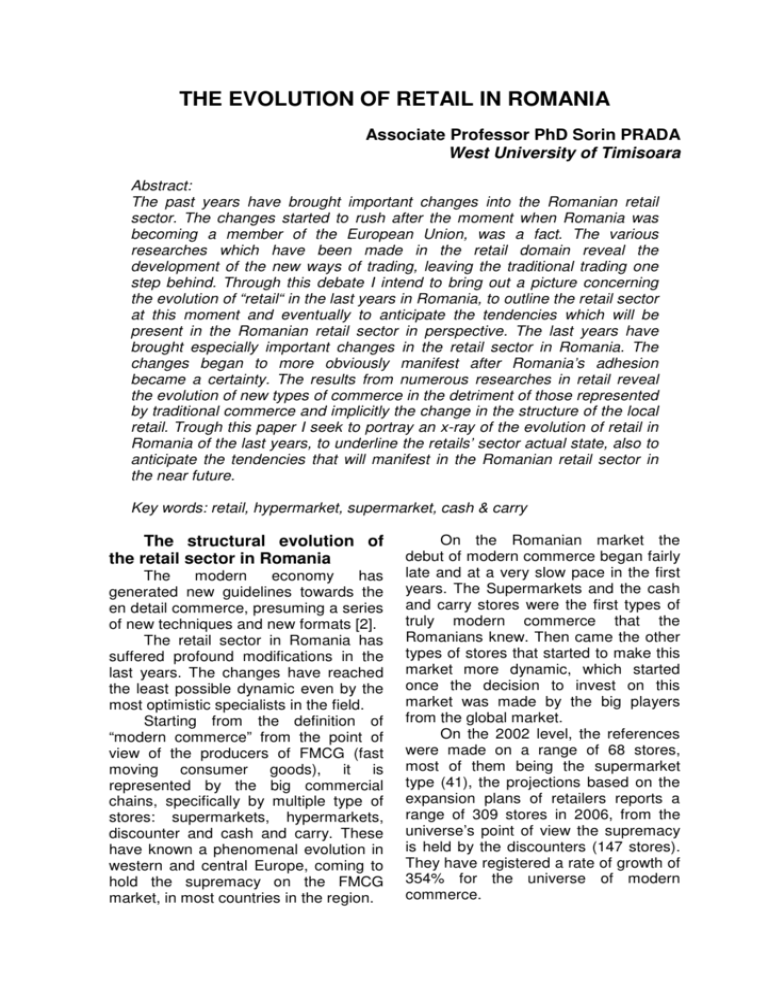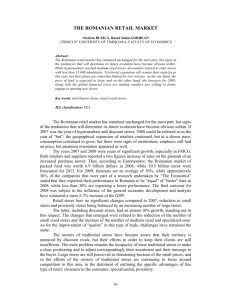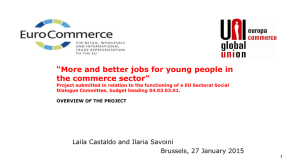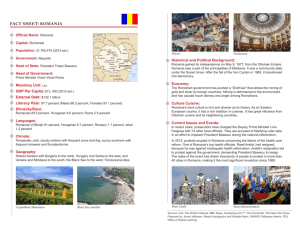the evolution of retail in romania
advertisement

THE EVOLUTION OF RETAIL IN ROMANIA Associate Professor PhD Sorin PRADA West University of Timisoara Abstract: The past years have brought important changes into the Romanian retail sector. The changes started to rush after the moment when Romania was becoming a member of the European Union, was a fact. The various researches which have been made in the retail domain reveal the development of the new ways of trading, leaving the traditional trading one step behind. Through this debate I intend to bring out a picture concerning the evolution of “retail“ in the last years in Romania, to outline the retail sector at this moment and eventually to anticipate the tendencies which will be present in the Romanian retail sector in perspective. The last years have brought especially important changes in the retail sector in Romania. The changes began to more obviously manifest after Romania’s adhesion became a certainty. The results from numerous researches in retail reveal the evolution of new types of commerce in the detriment of those represented by traditional commerce and implicitly the change in the structure of the local retail. Trough this paper I seek to portray an x-ray of the evolution of retail in Romania of the last years, to underline the retails’ sector actual state, also to anticipate the tendencies that will manifest in the Romanian retail sector in the near future. Key words: retail, hypermarket, supermarket, cash & carry The structural evolution of the retail sector in Romania The modern economy has generated new guidelines towards the en detail commerce, presuming a series of new techniques and new formats [2]. The retail sector in Romania has suffered profound modifications in the last years. The changes have reached the least possible dynamic even by the most optimistic specialists in the field. Starting from the definition of “modern commerce” from the point of view of the producers of FMCG (fast moving consumer goods), it is represented by the big commercial chains, specifically by multiple type of stores: supermarkets, hypermarkets, discounter and cash and carry. These have known a phenomenal evolution in western and central Europe, coming to hold the supremacy on the FMCG market, in most countries in the region. On the Romanian market the debut of modern commerce began fairly late and at a very slow pace in the first years. The Supermarkets and the cash and carry stores were the first types of truly modern commerce that the Romanians knew. Then came the other types of stores that started to make this market more dynamic, which started once the decision to invest on this market was made by the big players from the global market. On the 2002 level, the references were made on a range of 68 stores, most of them being the supermarket type (41), the projections based on the expansion plans of retailers reports a range of 309 stores in 2006, from the universe’s point of view the supremacy is held by the discounters (147 stores). They have registered a rate of growth of 354% for the universe of modern commerce. The adhesion of Romania to the European Union represents a factor that has brought its significant contribution to the changes that underwent in the distribution sector. The expansion of Hyper and Supermarket networks modifies the consumer behavior. Same as other countries that have adhered to the EU, the commerce in Romania also suffered significant transformations. These began to seriously manifest after the moment that the adhesion became a certainty. The results of numerous researches in retail revealed the evolution of new formats of commerce in the detriment of those represented by traditional commerce and implicitly the change of the local retail’s structure. The FMCG (fast moving consumer goods) market in Romania has been for a few years marked by a sustained increase, modern retail being one of the factors that contributed decisively to this tendency, new commercial formats facilitating the possibility of buying a significant amount of large consumption goods. As a result the value of sales made through the forms of modern commerce has topped out in 2005 in the area of 3 billion euro (3.75 billion dollars) an increase of 50% from the year before. On the other hand, the large consumer goods market in Romania is estimated to 10-12 billion dollars, a value that may vary regarding the level to witch the prices are being analyzed [6]. The same tendency is also noticed by the results of Shopper’s Trends study, witch states that modern formats have reached at the end of 2005, almost a quarter of the value of sales in the FMCG sector in Romania. If in 2003 the type of formats like supermarket, hypermarket, cash & carry or discount store represented only 10% of the value of FMCG sales, in 2005 the retail quota went up to 23%. The study shows that in the urban environment the 170 most important factors in choosing a store to shop in are diversity of goods, the quality-price balance and the special offers made by the stores. At the same time, supermarkets and hypermarkets represent the most frequented places in modern commerce, drawing in 30-50% of the monthly purchases, concludes a study done by AC Nilsen [6]. The local FMCG market grew in value in 2005 by 25% from previous year, shown by a study done by GFK, the market registering a trend of ascension since 2002. The aggressive expansion of super and hypermarkets has favored in the year 2005 the growth of the FMCG sector by 30% as value and 12% as volume, after all 3 segments of the FMCG market (eatable products, non eatable products and drinks) registered positive evolutions according to a MEMRB [6] research. Usually, buyers purchase small quantities of products, noticeable both for eatable products (63.7%), and for non eatable but regularly used (69.5%). Also, one may see a constant tendency of decrease of this fashion of acquisition in favor of high quantity shopping, sufficient for longer periods of time, this according to results of a study made by Daedalus Consulting [6]. In Romania the ratio of modern commerce in the total of retail sales grew to 39% in the year 2007 compared to the 19% that it registered in 2001. The evolution of modern Romanian retail was still very dynamic in the last 3 years, considering the fact that of a 19% of market total in 2001, this segment grew to 27% in 2005, 33% in 2006 and 39% in 2007. Although the retail market in Romania has known a much faster development then its neighboring states or those in Western Europe, the modern commerce in Romania has a much smaller ratio then in Western Europe countries, where it reaches 99.6% in France and 94.3% in Spain from total sales value [7]. On the other side, Romania, in 2006 occupied the second place in Europe considering sales per m² in modern commerce with 10.200 Euro. The retailer with the biggest sales per m² in 2006 was Metro Cash & Carry who registered sales of 10.300 Euro/ m², followed by Carrefour with 9.775 Euro/ m². On third and fourth place are the Billa and Plus stores which registered sales of 9.302 Euro/ m² and 7800 Euro/ m² [10]. The actual state of the retail structure in Romania The most important players on the Romanian retail market are: Metro, Rewe, Carrefour, Louis Delhaize, Schwarz, Auchan and Tangleman. According to a classification in the year 2007 the Romanian top of retailers looked like this [5]: Table 1 Nr. Crt. 1 2 3 4 5 6 7 Network Metro Selgros Carrefour Billa Real Rewe Auchan The Romanian Top of retailers C.A. 2006 C.A. 2007 Variation (Bill. lei) (Bill. lei) (%) 5.306 5.036 5,4 2.741 2.156 23,8 2.426 1.978 22,6 1.252 1.062 25,6 1.218 289 321,0 846 313 170,0 457 67 582,0 8 9 10 11 12 13 Plus 422 286 Artima 343 275 Interex 320 203 Pic 217 215 La Fourmi 104 71 Ethos 73 48 TOTAL 15.725 11.999 Source: Market Magazine nr.42/2008; *temporary data, business figure The Romanian commerce market is divided between hypermarkets and supermarkets, each of them holding in the year 2007 a market quota of 15%, followed by the discount stores with 5% and the cash &carry, with 4%, in the total of the retail market [10]. In Bucharest, modern commerce represents 70% of the total of commerce [8] At present time, in Romania as a number of units, modern retail is thus structured: 74 hypermarkets, 88 supermarkets, 152 discount stores and 40 cash & carry stores [7]. Nr. Of Stores 23 17 11 28 15 52 5 47,0 52 24,7 21 57,6 11 1,0 4 46,5 14 52,0 17 31,1 according to the 2007 So as a number of units we see a fast evolution, the most spectacular expansion being that of the discounters followed by the hypermarkets. The cash & carry sector represented by Metro and Selgros, as we can observe is in a period of stagnation, having the smallest evolution, contrary both companies will restart their plans for expansion [8]. The most important retail organizations, the year they entered the Romanian market and the number of establishments held by them presently are the following: 171 On the hypermarket segment Retailer Entry Stores Year Carrefour, 2001 14 Real, 2006 Auchan, 2006 Cora 2003 Pic, 2004 Spar 2006 Kaufland, 2005 On the discount segment Retailer Entry Year Penny 2002 Market Profi 2001 Plus 2005 Discount 15 5 3 4 1 32 Stores 28 45 55 Perspective overlooking the evolution of the retail sector in Romania It is fairly easy to anticipate the fact that in the next years, the formats of modern commerce will gain more ground to the detriment of traditional commerce. The most dynamic sector will be of the discount type of networks, with an increase estimated to 437% until 2010, meanwhile the hypermarkets and the supermarkets will register an increase of around 84%. The evolution of modern commerce will affect the situation of traditional commerce, taking into account what happend in the countries of Central Europe. All this aside, until now there is no record of spectacular changes from the traditional stores point of view, according to a study done by Euromonitor [9]. According to a study done by the institute of market research GFK, the international retail chains brought with 172 Table 2 On the supermarket segment Retailer Entry Stores Year Mega 1995 20 Image Interex, 2002 11 La Fourmi 1992 14 Spar 2006 15 Billa 1999 28 On the cash & carry segment Retailer Entry Stores Year Metro 1996 23 Selgros 2001 17 them, in the first years after Romania joined the EU, the change of the structure of the local commerce and a higher competition on the market. The study anticipates for the next years a shift of control on the market and implicitly on the price from the producers to the retailers, something that will generate the trend of prices going down on the unique market, because of the rising competition between traders. Through the offensive of the big international retail chains, the modern commerce will reach a ratio of 50% on the romanian market of large consumption goods until 2010, from the 30% it was at the end of 2006. Small stores will continue to exist on the market, but their ratio will drop to 56% in 2006 and down to 41% of the total of large consumer goods sales until 2010. Otherwise, modern commerce has developed mostly to the detriment of the foods markets and boutiques, which lost ground starting with the year 1998, when they held a ratio of 19% of the FMCG sales. At the start of 2007, they held 5% of the market, and by 2010 it is expected for them to reach mearly 3%, according to data from GfK [6]. If we take into acount the fact that that 8% of the international retailers would like to open a store in Romania in the next 2 years, and that according to a study of International Retailer’s Survey, done by the International Council of Shopping Centers (ICSC), working in collaboration with Cushman & Wakefiend and Real estate Publishers (REP), Romania is situated on the third place on the top of most attractive countries for the expansion of retailers in the next 2 years, after Russia and the Czech Republic, we can conclude that the development of modern retail will have an increased dynamic [4]. Taking into account what happened in the countries in Central Europe, the evolution of modern commerce will affect the situation of traditional commerce. All the same, for now we have not registered spectacular changes from the traditional stores point of view. They can survive if they learn how to renew their format, if they will have new products on their shelves, if they diversify the range of products they offer to the clientele, if they promote their own brands (a much costly option for most), if they organize more promotional campaigns with the producers of FMCG, and last but not least, if they implement programs to make the clientele loyal to them (credit cards, discounts, credits etc). GFK estimates that by the level of 2010 modern commerce will hold 50% of the Romanian market of large consumer goods, regarding to the 30% it held in the beginning of 2007. My opinion is that, in full evolution, modern commerce is still searching for its place and role on Romanian commercial plain, experimenting with formats and attributes according to diverse conditions or opportunities which they face or notice. The survival of small formats will only realize it’s self by innovation. In order to reposition them selves it is recommended that the small retailers should exploit what consumers desire and the big retailers can’t offer. Innovations will only take effect under the conditions that the small retailers will have the capacity to understand the consumer’s behavior. Baltas and Papastathopolou (2003) agree that the simultaneous examination of the criteria of brand choosing, the criteria of store choosing, also of the demographic characteristics of shoppers will considerably upgrade the level of understanding of consumer behavior, something that provides the traders a perspicacity to empirically determine the criteria of segmentation of the marketing strategies that they will undertake [1]. The small retailers will only survive if they will learn how to renew their format, if they will have on their shelves the latest products, if they diversify their range of products, if they promote their own brands (an option too costly for most), if they organize more promotional campaigns along with the FMCG producers, and finally if they implement loyalty programs with credit cards, discounts and credits [9]. The majority of small neighborhood stores that sell commonly use products, that are unspecialized will disappear in the next few years. A chance to stay on the market will have only those who will differentiate and bring for their costumers individual benefits [3]. 173 REFERENCES [1] Baltas G., Papastathopolou P., Management, 31, 10, 2003. International Journal of Retail&Distribution [2] Niţă V., Corodeanu D., Merchandising, Ed. Tehnopersss, 2007. [3] Prada S., Banat Business, Nr 185, October 2008. [4] **** Banat Business, nr. 185, octombrie 2008. [5] **** The Market, nr.42, 2008. [6 ]**** Retail 2006, Mediafax Annual Report, 2007. [7] www.dailybusiness.ro. [8] www.financiarul.ro. [9] www.markmedia.ro. [10] www.standard.ro. 174







